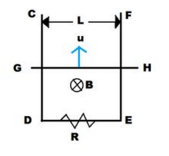Slide away

C D E F is a fixed conducting smooth frame in vertical plane. A conducting uniform rod G H of mass m can move vertically and smoothly without loosing contact with the frame. G H always remains horizontal and is given a velocity U upward and released. Taking acceleration due to gravity as g and resistance attached to D E as R , the time taken by the rod to reach the highest point is ___________ .
This section requires Javascript.
You are seeing this because something didn't load right. We suggest you, (a) try
refreshing the page, (b) enabling javascript if it is disabled on your browser and,
finally, (c)
loading the
non-javascript version of this page
. We're sorry about the hassle.
1 solution
I did it the same way, but I think you can improve the options, by making them more tricky, because dimensional analysis ruins the problem. Only the second and third options have the dimension of time, and among them the term inside ln() which should be dimensionless is satisfied only by second option.
Of course, none of these could have been the answer, but someone mat get lucky, because now they have 2 options to choose from, the second and the fourth one.
Log in to reply
well ,to be honest i solved it using Dimensional Analysis !!! @Soumava Pal
the emf induced due to motion of conductor ϵ = ∫ ( v × B ) . d l Let the velocity of conductor at any time be "v" ϵ = B L v Current flowing I = R B L v Force on the conductor F = ∫ I d l × B F = I L B = R B 2 L 2 v ↓ e q u a t i o n − m d t d v = R B 2 L 2 v + m g − m R B 2 L 2 v + m g d v = d t Integrate and solve